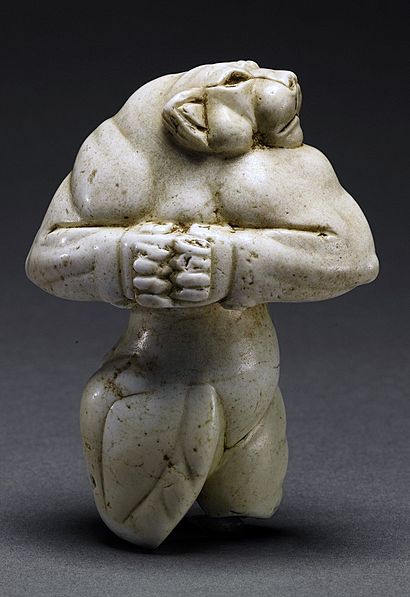Guennol Lioness facts for kids
Quick facts for kids Guennol Lioness |
|
|---|---|
 |
|
| Year | Third millennium B.C. |
| Type | Limestone |
| Dimensions | 8.3 cm (3.25 in) |
| Location | Private collection |
The Guennol Lioness is a very old statue from Mesopotamia. It is about 5,000 years old! People found it near Baghdad, in Iraq. This special sculpture looks like a strong lioness mixed with a human. It's often called a "lioness-woman."
This amazing sculpture is made of limestone. It is just over 8 centimeters (3.25 inches) tall. That's about the size of a small action figure! Experts say it's one of the last great artworks from the start of civilization still owned by a private person.
Contents
A Very Expensive Statue
The Guennol Lioness became very famous when it was sold. On December 5, 2007, it was sold at an auction house called Sotheby's. It went for an incredible $57.2 million! Before the auction, experts thought it would sell for much less, around $14 million to $18 million.
Breaking Auction Records
When it was sold in 2007, the Guennol Lioness was the most expensive sculpture ever sold at an auction. It cost more than a sculpture by the famous artist Pablo Picasso. However, its record was later broken. In 2010, a sculpture called L'Homme qui marche I (Walking Man I) by Alberto Giacometti sold for even more money.
History of the Lioness-Woman
This unique lioness-woman sculpture is an Elamite figure. People believe it was made around 3000 to 2800 B.C. This makes it incredibly old!
What Was Happening Then?
The time when the Guennol Lioness was made was very important in history. It was around the same time that people first started using the wheel. It was also when cuneiform writing began to develop. Cuneiform was one of the first writing systems. Plus, the first big cities were starting to appear. So, this statue comes from a time of huge changes for humans.
Meaning of the Lioness Figure
Many ancient Near East gods and goddesses were shown as anthropomorphic figures. This means they had both human and animal features. For example, they might have a human body with an animal head. People in Mesopotamia believed that combining the best parts of different animals and humans gave them special power over the world.
The lioness was often respected in ancient cultures. This is because female lions are very good at hunting together. It's possible that the nearby Sumerians learned this powerful artistic idea from the Proto-Elamites.
See also
In Spanish: Leona Guennol para niños

